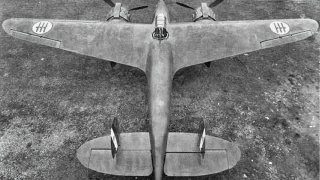Lynx: The Story of the Worst Bomber to Ever Fly
You’ve heard of the next-generation U.S. Air Force B-21 Raider stealth bomber? That may someday be the best bomber ever. But what about the worst bomber of all time? Meet Italy's Lynx from World War II.
You’ve heard of the next-generation U.S. Air Force B-21 Raider stealth bomber? That may someday be the best bomber ever. But what about the worst bomber of all time?
This “award” goes to Benito Mussolini’s Italy and his dream of a conquering aerial hero – the Breda Ba.88 Lince or “Lynx.”
The Lynx was so bad it sometimes couldn’t even fly. The Italians became frustrated in World War Two, and they simply kept it on the ground to fool the allies and make it look like they had overwhelming numbers of airplanes.
Lynx: Meet the Worst Bomber Ever
The Lynx started off in 1936 in Mussolini’s propaganda films. It looked like a formidable bomber at the time. It was a twin-engine monoplane with rounded vertical fins and a cigar-shaped fuselage. Each engine had 1,000 horsepower. In 1937, Il Duce was happy because the Lynx was actually setting world records for speed. It averaged over 321 miles per hour when flying 62 miles and nearly 300 miles per hour when it went 621 miles. The Italians thought it could be a “bomber killer.”
It Was Armed for Ground Attack
The weapons weren’t too bad. Three 12.7mm guns were in the nose and the cockpit had a 7.7mm gun in the rear. They later added a 20mm cannon in the nose.
The Early Success Hid Problems
But then the trouble started. Those record speeds were attained when the airplane was “slick” – before it had any military equipment on board. The extra weight added made the Lynx into a sick kitty cat. The air frame became unstable, and all the speed and performance measures started dying. The production lines sprang into action despite the initial problems and 149 were made. The Italian air force took the airplane, ignored the bad signs, and sent them into combat versus the French in 1940.
Combat Was a Disappointment
A dozen of the Italian bombers made a run against targets in Corsica. This operation was ineffective and showed that the Lynx was going to have a troubled path forward. Then Italy tried their luck against the British in Libya. The desert environment necessitated sand filters on the engines. But that resulted in the powerplants suddenly becoming overheated. This robbed the engines of the power they had in the first place.
This Is Going to Be Bad
In 1940, in a mission over Sidi Barrani in North Africa, the performance became downright embarrassing. The bombers barely gained altitude and couldn’t maintain a formation. The speed was terrible – only about 150 miles per hour. Italian pilots began to complain. This airplane was clearly overweight and had no maneuverability. They would be sitting ducks if challenged by enemy fighters and that’s what happened as the Lynx started getting shot down in numbers.
The Lynx Needed To Be Put to Death
By 1941, they were quickly grounded and cannibalized – maintenance crews took the 20mm automatic cannons and other guns and anything of military use off the bombers. They towed the airplanes and used them as decoys when British bombers attacked. Despite the complete failure, the Italians kept producing them. Sixty-seven more came off the production line. The Italian air force refused to take them and off they went to be scrapped as quickly as they were made.
The Lynx is a cautionary tale in what happens when an inexperienced and untested military tries to bring what they think is a “hot” airplane into service without fully running it through its paces. The Lynx never hunted and killed much of anything. And it has to go down as the worst bomber ever.
About the Author
Dr. Brent M. Eastwood is the author of Humans, Machines, and Data: Future Trends in Warfare. He is an Emerging Threats expert and former U.S. Army Infantry officer. You can follow him on Twitter @BMEastwood. He holds a Ph.D. in Political Science and Foreign Policy/ International Relations.
Image is Creative Commons.


